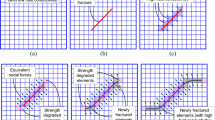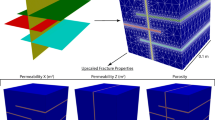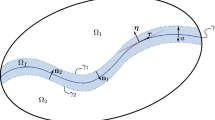Abstract
Natural discontinuities are the major concern when considering mass transport in engineered barrier systems and their host rocks. Numerical simulations of highly fractured geological formations are limited because of the contradiction between results accuracy and computational costs. To alleviate such a contradiction, this study proposes an improved fracture continuum method to simulate the radioactive spreading in a complex 3-D fracture system. With Boolean operations and the unified pipe-network method, discontinuities are mapped on structured subdomains and standardized to equivalent paths. Moreover, adaptive mesh refinement is utilized to ease the complexity further. We verify the accuracy of this method in two metric cases, and results show that perfect agreement is achieved with analytical solutions. This method demonstrates its applicability to the simulation of a nuclear leak in a repository for high-level radioactive waste. Effects of the maximum refinement level are discussed. For a room-scale problem, flow rates and mass fluxes on boundary surface converge to stable values when the maximum refinement level is larger than 4. An extensive case with complex fracture networks is modeled and compared with the conventional finite-difference method. The proposed method is capable of conducting robust results with significantly lower computational complexity and negligible errors by avoiding ill-conditioned mesh elements.













Similar content being viewed by others
Abbreviations
- AMR:
-
Adaptive mesh refinement
- EDFM:
-
Embedded discrete-fracture modeling
- HLW:
-
High-level radioactive waste
- pEDFM:
-
Projection-based embedded discrete-fracture modeling
- UPM:
-
Unified pipe-network method
- \( b \) :
-
Fracture hydraulic aperture
- \( c \) :
-
Solute concentration
- \( \varvec{k} \) :
-
Permeability tensor
- \( k_{i\tau } \) :
-
Permeability of pipe \( P_{i\tau } \)
- \( l \) :
-
Length of simulated domain size
- \( \varvec{n}_{\varvec{i}} ,\varvec{n}_{\phi } \) :
-
Unit vector of grid surface represented by node \( N_{i} \), \( N_{\phi } \)
- \( \Delta n_{i\tau } \) :
-
Length of pipe \( P_{i\tau } \)
- \( p \) :
-
Total hydraulic pressure
- \( p_{i} ,p_{j} , \ldots ,p_{q} , p_{\tau } ,p_{\phi } \) :
-
Total hydraulic pressure at the corresponding node
- \( q_{i} \) :
-
Net flow rate out of controlled volume of node \( N_{i} \)
- \( r \) :
-
Ratio of grid sizes in two consecutive refinement levels
- \( s_{i\tau } \) :
-
Cross area of the pipe \( P_{i\tau } \)
- \( t \) :
-
Time variable
- \( \varvec{v} \) :
-
Velocity of fluid
- \( \varvec{v}_{\varvec{i}} ,\varvec{v}_{\phi } \) :
-
Velocity of fluid at node \( N_{i} \), \( N_{\phi } \)
- \( w \) :
-
Width of rectangular fracture
- \( \Delta x_{R} \) :
-
Size of grids at mesh-refinement level \( R \)
- \( A_{i} ,A_{\phi } \) :
-
Area of grid surface represented by node \( N_{i} \), \( N_{\phi } \)
- \( D \) :
-
Hydraulic dispersion coefficient
- \( D^{*} \) :
-
Molecular diffusion coefficient in free water
- \( F_{i} \) :
-
Set of all nodes representing surfaces of fine grids sharing a nonconforming interface with the node \( N_{i} \)
- \( H \) :
-
Total hydraulic head
- \( J_{{R_{d} }} \) :
-
Mass flux of solute
- \( M \) :
-
Solute emission on all boundaries
- \( M1,M2, M3, M4 \) :
-
Solute emission on the corresponding boundary
- \( N_{i} ,N_{j} , \ldots ,N_{q} ,N_{\tau } ,N_{\phi } \) :
-
Face-centered node of the corresponding grid surface
- \( P_{ij} ,P_{jm} , \ldots ,P_{pq} \) :
-
Interconnected pipe between corresponding nodes
- \( Q \) :
-
Total flow rate on boundary
- \( R \) :
-
Mesh-refinement level
- \( R_{d} \) :
-
Maximum mesh-refinement level
- \( R_{t} \) :
-
Retardation coefficient
- \( S \) :
-
Source or sink term
- \( T_{i} \) :
-
Set of all nodes connecting to the node \( N_{i} \)
- \( \alpha_{\text{L}} \) :
-
Dispersivity in the longitudinal direction
- \( \theta \) :
-
Dip angle of fracture
- \( \phi \) :
-
Strike angle of fracture
- \( \lambda \) :
-
Decay constant of radioactive material
- \( \mu \) :
-
Dynamic viscosity of fluid
References
Bear J (1988) Dynamics of fluids in porous media. Dover, New York
Berger MJ, Colella P (1989) Local adaptive mesh refinement for shock hydrodynamics. J Comput Phys 82:64–84. https://doi.org/10.1016/0021-9991(89)90035-1
Berger MJ, Oliger J (1984) Adaptive mesh refinement for hyperbolic partial differential equations. J Comput Phys 53:484–512. https://doi.org/10.1016/0021-9991(84)90073-1
Berkowitz B (2002) Characterizing flow and transport in fractured geological media: a review. Adv Water Resour 25:861–884. https://doi.org/10.1016/S0309-1708(02)00042-8
Berkowitz B, Bear J, Braester C (1988) Continuum models for contaminant transport in fractured porous formations. Water Resour Res 24:1225–1236. https://doi.org/10.1029/WR024i008p01225
Blessent D, Jørgensen PR, Therrien R (2014) Comparing discrete fracture and continuum models to predict contaminant transport in fractured porous media. Groundwater 52:84–95. https://doi.org/10.1111/gwat.12032
Bodin J, Porel G, Delay F, Ubertosi F, Bernard S, de Dreuzy JR (2007) Simulation and analysis of solute transport in 2D fracture/pipe networks: the SOLFRAC program. J Contam Hydrol 89:1–28. https://doi.org/10.1016/J.JCONHYD.2006.07.005
Botros FE, Hassan AE, Reeves DM, Pohll G (2008) On mapping fracture networks onto continuum. Water Resour Res. https://doi.org/10.1029/2007WR006092
Chen Y, Ma G, Li T, Wang Y, Ren F (2018a) Simulation of wormhole propagation in fractured carbonate rocks with unified pipe-network method. Comput Geotech 98:58–68. https://doi.org/10.1016/J.COMPGEO.2017.11.009
Chen Y, Ma G, Wang H (2018b) Heat extraction mechanism in a geothermal reservoir with rough-walled fracture networks. Int J Heat Mass Transf 126:1083–1093. https://doi.org/10.1016/J.IJHEATMASSTRANSFER.2018.05.103
Chen Y, Ma G, Wang H, Li T (2018c) Evaluation of geothermal development in fractured hot dry rock based on three dimensional unified pipe-network method. Appl Therm Eng 136:219–228. https://doi.org/10.1016/J.APPLTHERMALENG.2018.03.008
Cornford SL, Martin DF, Graves DT, Ranken DF, Le Brocq AM, Gladstone RM, Payne AJ, Ng EG, Lipscomb WH (2013) Adaptive mesh, finite volume modeling of marine ice sheets. J Comput Phys 232:529–549. https://doi.org/10.1016/J.JCP.2012.08.037
Edwards MG (1996) Elimination of adaptive grid interface errors in the discrete cell centered pressure equation. J Comput Phys 126:356–372. https://doi.org/10.1006/JCPH.1996.0143
Freeze RA, Cherry JA (1979) Groundwater. Prentice-Hall, Englewood Cliffs
Geiger-Boschung S, Matthäi SK, Niessner J, Helmig R (2009) Black-oil simulations for three-component, three-phase flow in fractured porous media. SPE J 14:338–354. https://doi.org/10.2118/107485-PA
Greaves D, Borthwick AGL (1999) Hierarchical tree-based finite element mesh generation. Int J Numer Methods Eng 45:447–471. https://doi.org/10.1002/(SICI)1097-0207(19990610)45:4%3C447:AID-NME592%3E3.0.CO;2-%23
Hyman JD, Karra S, Makedonska N, Gable CW, Painter SL, Viswanathan HS (2015) DFNWorks: a discrete fracture network framework for modeling subsurface flow and transport. Comput Geosci 84:10–19. https://doi.org/10.1016/J.CAGEO.2015.08.001
Jerbi C, Fourno A, Noetinger B, Delay F (2017) A new estimation of equivalent matrix block sizes in fractured media with two-phase flow applications in dual porosity models. J Hydrol 548:508–523. https://doi.org/10.1016/J.JHYDROL.2017.03.028
Jiang J, Younis RM (2017) An improved projection-based embedded discrete fracture model (pEDFM) for multiphase flow in fractured reservoirs. Adv Water Resour 109:267–289. https://doi.org/10.1016/J.ADVWATRES.2017.09.017
Krysl P, Grinspun E, Schröder P (2003) Natural hierarchical refinement for finite element methods. Int J Numer Methods Eng 56:1109–1124. https://doi.org/10.1002/nme.601
Krysl P, Trivedi A, Zhu B (2004) Object-oriented hierarchical mesh refinement with CHARMS. Int J Numer Methods Eng 60:1401–1424. https://doi.org/10.1002/nme.1008
Larsson M, Odén M, Niemi A, Neretnieks I, Tsang CF (2013) A new approach to account for fracture aperture variability when modeling solute transport in fracture networks. Water Resour Res 49:2241–2252. https://doi.org/10.1002/wrcr.20130
Lee SH, Lough MF, Jensen CL (2001) Hierarchical modeling of flow in naturally fractured formations with multiple length scales. Water Resour Res 37:443–455. https://doi.org/10.1029/2000WR900340
Li L, Lee SH (2008) Efficient field-scale simulation of black oil in a naturally fractured reservoir through discrete fracture networks and homogenized media. SPE Reserv Eval Eng 11:750–758. https://doi.org/10.2118/103901-PA
Lipnikov K, Morel J, Shashkov M (2004) Mimetic finite difference methods for diffusion equations on non-orthogonal non-conformal meshes. J Comput Phys 199:589–597. https://doi.org/10.1016/J.JCP.2004.02.016
Ma G, Chen Y, Jin Y, Wang H (2018) Modelling temperature-influenced acidizing process in fractured carbonate rocks. Int J Rock Mech Min Sci 105:73–84. https://doi.org/10.1016/J.IJRMMS.2018.03.019
Maryška J, Severýn O, Vohralík M (2005) Numerical simulation of fracture flow with a mixed-hybrid FEM stochastic discrete fracture network model. Comput Geosci 8:217–234. https://doi.org/10.1007/s10596-005-0152-3
McKenna SA, Reeves PC (2006) Fractured continuum approach to stochastic permeability modeling. AAPG special volumes, pp 173–186. https://doi.org/10.1306/1063815CA53234
Neuman SP (2005) Trends, prospects and challenges in quantifying flow and transport through fractured rocks. Hydrogeol J 13:124–147. https://doi.org/10.1007/s10040-004-0397-2
Ngo TD, Fourno A, Noetinger B (2017) Modeling of transport processes through large-scale discrete fracture networks using conforming meshes and open-source software. J Hydrol 554:66–79. https://doi.org/10.1016/J.JHYDROL.2017.08.052
Palle N, Dantzig JA (1996) An adaptive mesh refinement scheme for solidification problems. Metall Mater Trans A 27:707–717. https://doi.org/10.1007/BF02648957
Pan JB, Lee CC, Lee CH, Yeh HF, Lin HI (2010) Application of fracture network model with crack permeability tensor on flow and transport in fractured rock. Eng Geol 116:166–177. https://doi.org/10.1016/J.ENGGEO.2010.08.007
Provatas N, Goldenfeld N, Dantzig J (1998) Adaptive mesh refinement computation of solidification microstructures using dynamic data structures. J Comput Phys 148:265–290. https://doi.org/10.1006/jcph.1998.6122
Reeves DM, Benson DA, Meerschaert MM (2008a) Transport of conservative solutes in simulated fracture networks: 1. Synthetic data generation. Water Resour Res. https://doi.org/10.1029/2007WR006069
Reeves DM, Benson DA, Meerschaert MM, Scheffler H-P (2008b) Transport of conservative solutes in simulated fracture networks: 2. Ensemble solute transport and the correspondence to operator-stable limit distributions. Water Resour Res. https://doi.org/10.1029/2008WR006858
Ren F, Ma G, Wang Y, Li T, Zhu H (2017a) Unified pipe network method for simulation of water flow in fractured porous rock. J Hydrol 547:80–96. https://doi.org/10.1016/J.JHYDROL.2017.01.044
Ren F, Ma G, Wang Y, Fan L, Zhu H (2017b) Two-phase flow pipe network method for simulation of CO2 sequestration in fractured saline aquifers. Int J Rock Mech Min Sci 98:39–53. https://doi.org/10.1016/J.IJRMMS.2017.07.010
Sudicky EA (1990) The Laplace Transform Galerkin technique for efficient time-continuous solution of solute transport in double-porosity media. Geoderma 46:209–232. https://doi.org/10.1016/0016-7061(90)90016-3
Svensson U (2001a) A continuum representation of fracture networks. Part I: method and basic test cases. J Hydrol 250:170–186. https://doi.org/10.1016/S0022-1694(01)00435-8
Svensson U (2001b) A continuum representation of fracture networks. Part II: application to the Äspö Hard Rock laboratory. J Hydrol 250:187–205. https://doi.org/10.1016/S0022-1694(01)00436-X
Tabarraei A, Sukumar N (2005) Adaptive computations on conforming quadtree meshes. Finite Elem Anal Des 41:686–702. https://doi.org/10.1016/J.FINEL.2004.08.002
Ţene M, Bosma SBM, Al Kobaisi MS, Hajibeygi H (2017) Projection-based embedded discrete fracture model (pEDFM). Adv Water Resour 105:205–216. https://doi.org/10.1016/J.ADVWATRES.2017.05.009
Wang Y, Ma G, Ren F, Li T (2017) A constrained Delaunay discretization method for adaptively meshing highly discontinuous geological media. Comput Geosci 109:134–148. https://doi.org/10.1016/j.cageo.2017.07.010
Xu Y, Cavalcante Filho JSA, Yu W, Sepehrnoori K (2017) Discrete-fracture modeling of complex hydraulic-fracture geometries in reservoir simulators. SPE Reserv Eval Eng 20:403–422. https://doi.org/10.2118/183647-PA
Yerry M, Shephard M (1983) A modified quadtree approach to finite element mesh generation. IEEE Comput Graph Appl 3:39–46. https://doi.org/10.1109/MCG.1983.262997
Yu D, Mei R, Shyy W (2002) A multi-block lattice Boltzmann method for viscous fluid flows. Int J Numer Methods Fluids 39:99–120. https://doi.org/10.1002/fld.280
Acknowledgements
This research was supported by the Research Training Program (RTP) scheme at UWA. The authors wish to thank the National Natural Science Foundation of China (NSFC) for their financial support (Nos. 51778029 and 51627812).
Author information
Authors and Affiliations
Corresponding author
Additional information
Publisher's Note
Springer Nature remains neutral with regard to jurisdictional claims in published maps and institutional affiliations.
Rights and permissions
About this article
Cite this article
Ma, G., Li, T., Wang, Y. et al. A Semi-Continuum Model for Numerical Simulations of Mass Transport in 3-D Fractured Rock Masses. Rock Mech Rock Eng 53, 985–1004 (2020). https://doi.org/10.1007/s00603-019-01950-1
Received:
Accepted:
Published:
Issue Date:
DOI: https://doi.org/10.1007/s00603-019-01950-1




